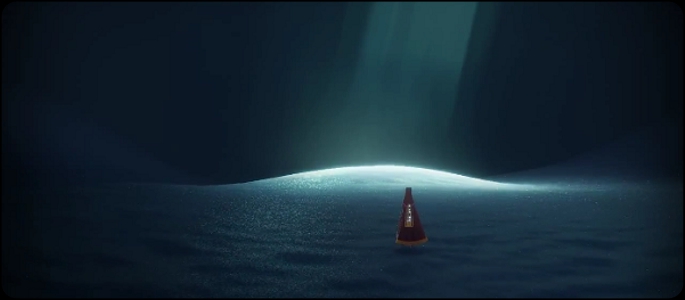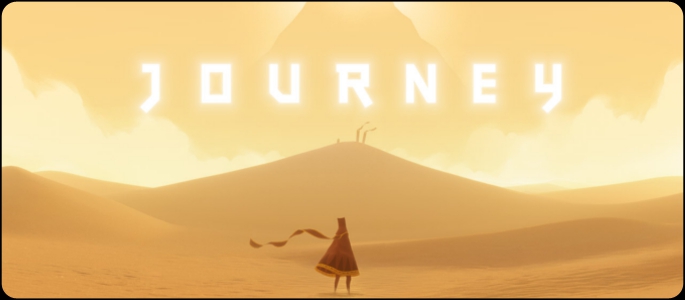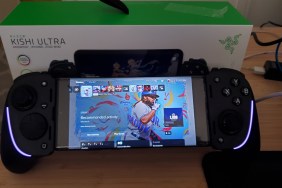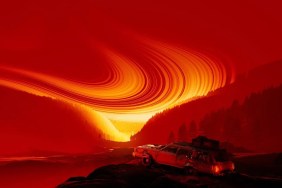thatgamecompany is often considered one of the best indie developers in existence, especially after their work with the phenomenal Flower. With that much pressure to live up to, their next venture, Journey is here. But does it live up to expectations?
The premise of Journey is simple – there’s a mountain with a heavenly light shining from its peak and you have to travel towards it. The game never tells you that’s what you have to do, and, other than letting you know what the controls are, offers no instruction as to where you need to go or what you need to do. But it doesn’t need to, you are immediately drawn towards the mountain, the only significant landmark you’ll see at the start of the game, and further obstacles and pathways are self-explanatory. The lack of a HUD, health bar and GPS-style map all serve to enhance thatgamecompany’s latest title, helping you forget that you are playing a ‘computer videogame’ and letting you enjoy Journey unadulterated.
But while it doesn’t look like any game before it, Journey does have more ‘traditional’ game elements than Flower, with much of the game being their take on platforming and simple puzzles. You play as a humanoid cloth creature who doesn’t speak other than by emitting rhythmical notes when you press circle. These notes affect the world around you, making altars glow, breathing life into other cloth beings and freeing them from imprisonment. Cloth is a huge part of the game – not only are the animals and plants made out of cloth, but the undulating sand itself moves and acts like a piece of cloth and the land is dotted with what look like giant sewing needle pinheads.
Despite much of the game being based in the desert, life is surprisingly abundant. Small cloth beings float in the air, grouped like schools of fish, moving as one body as they circle a rock or half-buried building. Emit a note near them and they’ll charge up your scarf with energy, allowing you to fly until the energy runs out. To lengthen your scarf and allow for more energy to be stored, you’ll need to find glowing symbols that are dotted around the game world. All of this is optional, though, as you can complete the whole game without paying much attention to your scarf length (although being able to fly makes the game easier).
Another creature you’ll encounter in the vast expanse of the desert looks like a simple (yet beautiful) piece of cloth, but acts much like a dolphin, playfully diving in and out of the sand around you while chirping musical notes. As you free them from various forms of captivity, the cloth-dolphins help you, pointing out places to go and lifting you over obstacles. The creatures’ AI is flawless – they act just like you’d imagine a real animal would, while staying out of the way and not obstructing your progress.
But what is more impressive is the visuals. Sand has never looked this good, even in real life, as you’ll even be able to spot individual sand grains sparkling in the sunlight. At one point you’ll be sliding down a particularly large sand dune, with cloth-dolphins all around you, and the sunset causing the sand to glow such a bright golden color that it’s eye-watering. It’s a perfect climactic moment that you don’t want to end, but it does, suddenly and abruptly.

From dazzling brightness you are cast down into soft darkness. Moving from the desert to the bottom of an ocean is a drastic change, yet timed perfectly. Just as the desert reaches the peak of its beauty – one based on an extravagant abundance of light – you are treated to a whole new beauty – one based on a scarcity of light. Here, underwater, you’ll encounter yet more cloth animals, like whales and jellyfish, which also aid your journey.
As you continue, you’ll also come across monstrous beasts that look like giant, stone versions of something out of flOw. Unlike the cloth creatures you met before, the stone monsters are out to hurt you, and, instead of making soft notes, they make coarse, loud and predatory sounds. After such tranquility, the addition of monsters is genuinely frightening – far more so than a standard horror game. The stone creatures swim above you as you make your way along the sea bed, looking for you (or any other cloth-based being) with glowing search light-like eyes that turn red if they find you. Once spotted, the monsters dive down at you and smash into you, shortening your scarf.
After the water levels, you’ll come to another environment and an enhancement of another. As they haven’t been revealed in trailers, I won’t spoil them. Suffice to say, they look incredible, and manage to change the pace up once again.
Equally incredible is the audio, with Austin Wintory’s serene classical music perfectly complementing the game’s gentler moments, and seamlessly shifting to playful, fast, desperate or scary, depending on the mood. Sound effects are also top notch, as the sound of a gale, sandstorm, or even a note being played underwater are all captured perfectly. With its glorious visuals and terrific music, Journey is an artistic masterpiece – thankfully, the gameplay is just as good.
Journeying through the game and lighting up the cloth world with your notes can be a compelling singleplayer experience, which is only enhanced with its multiplayer. There’s no matchmaking or loading screens, another player might just suddenly stride past you on their own unique ‘journey’. The first time I met someone, the experience was fleeting, we shared each other’s company across a few dunes, but as I looked up to watch a falling star, the desert swallowed him/her up. I met another traveler later on, who tagged along with me until the end. We couldn’t talk to each other, except for letting out notes, but we shared a connection as we tried to brave the elements and survive, the loneliness of the singleplayer quest changed to be the intimacy of camaraderie. You don’t see their PSN username until the end of the game, but even that I would have preferred to do without, the experience is all the more incredible when anonymous – you are just two pilgrims on a quest to reach a singular goal.
Unfortunately, this quest lasts less than two hours, making it a very short game. You’ll likely complete the game in a single sitting, and the game has limited replayability – you might play it in singleplayer, then multiplayer, or try to look for all the glowing symbols and hidden creatures in the game – but most people probably won’t play it more than a few times.
Some will be disappointed by how quickly the game ends, but the two hours that mark your journey is the most incredible and unique you can possibly have on your PS3. Flower is often used as an example of how games are art, but Flower is a mere sketch compared to the oil painting that is Journey. With perfect music, gorgeous visuals and powerful single and multiplayer experiences, Journey is the PlayStation Network’s must own magnum opus.
PlayStation LifeStyle’s Final Score
+ Absolutely beautiful +/- Short, but sweet |
 |
–








